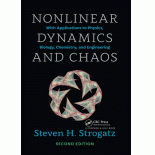
Interpretation:
To find characteristic polynomial
Solve the given system of linear equations and write the general solution.
Classify the fixed points at the origin.
Solve the system subject to the primary condition
Concept Introduction:
Equations for two dimensional linear system are
The above linear system expressed in the form
The standard characteristics polynomials is
Answer to Problem 1E
Solution:
The characteristic polynomial for the linear system of equation is
Overall solution of the system is
The nature of fixed points for the given linear equations is unstable and growing.
The solution of the system for initial condition
Explanation of Solution
The linear system equations are
And,
The above linear equations can be written in matrix form as
The standard characteristic polynomial is
Here,
Substitute
This is the necessarycharacteristic polynomial.
To find the eigenvalues of the above characteristic polynomial, find its roots.
Using characteristic equation, find eigenvectors for the given eigenvalues.
General solution of the system is written as
Here,
The fixed points at the origin can never be stable if both eigenvalues are positive and real. Hence the nature of fixed points for the given linear equations is unstable and growing. This means the stream lines are moving out from the center of the origin. Also,
Initial condition is
Substitute
Solving for
Substituting this values in general solution of time t,
This
The characteristic equation, eigenvalues, and eigenvectors are found for the given system of linear equations. Also general solution and solution of the given initial condition is found.
Want to see more full solutions like this?
Chapter 5 Solutions
Nonlinear Dynamics and Chaos
- Pls help asaparrow_forwarda. f(x) = 3 — — x 13. Which of the following has a horizontal asymptote at y = 0 ? 1 - X c. f(x) = 1 b. f(x) == X+2 1 = d. all of the above 17x+4 1 14. What is true about the function f(x)= as x∞o? x+4 a. f(x)0 from above b. f(x)0 from below c. f(x) → 1/1/1 d. f(x)→ ∞ 15. Which function is always positive? a. f(x)= 2 5x+4 1 1 b. f(x)= c. f(x)= d. B and C x²-2x-15 (x-5)²arrow_forwardPls help asaparrow_forward
- Algebra & Trigonometry with Analytic GeometryAlgebraISBN:9781133382119Author:SwokowskiPublisher:Cengage
 Elementary Linear Algebra (MindTap Course List)AlgebraISBN:9781305658004Author:Ron LarsonPublisher:Cengage Learning
Elementary Linear Algebra (MindTap Course List)AlgebraISBN:9781305658004Author:Ron LarsonPublisher:Cengage Learning Linear Algebra: A Modern IntroductionAlgebraISBN:9781285463247Author:David PoolePublisher:Cengage Learning
Linear Algebra: A Modern IntroductionAlgebraISBN:9781285463247Author:David PoolePublisher:Cengage Learning  Algebra and Trigonometry (MindTap Course List)AlgebraISBN:9781305071742Author:James Stewart, Lothar Redlin, Saleem WatsonPublisher:Cengage Learning
Algebra and Trigonometry (MindTap Course List)AlgebraISBN:9781305071742Author:James Stewart, Lothar Redlin, Saleem WatsonPublisher:Cengage Learning College AlgebraAlgebraISBN:9781305115545Author:James Stewart, Lothar Redlin, Saleem WatsonPublisher:Cengage Learning
College AlgebraAlgebraISBN:9781305115545Author:James Stewart, Lothar Redlin, Saleem WatsonPublisher:Cengage Learning





